When we made a research for reliable Namibian Expedition Car Rental companies, we stumbled over Safari Car Rental in January 2019.
They seemed to be one of the best companies in Namibia for cars we were searching for.
So I got in touch with Kimi - a very friendly and supportive (german speaking) lady, from Safari Car Rental - who gave me all the information I needed over the months until December. So nothing to complain here.
We booked the "Toyota Expedition DC 4x4 2,8TD AUTO", which is (apart from the even bigger version with a second RTT) the best car, they have been offering.
It was additionally equipped with a HD lifterjack, offroad suspension, snorkel, dual fuel tank and some other useful bits and we thought, it might be a good idea to have all this extras on the car.
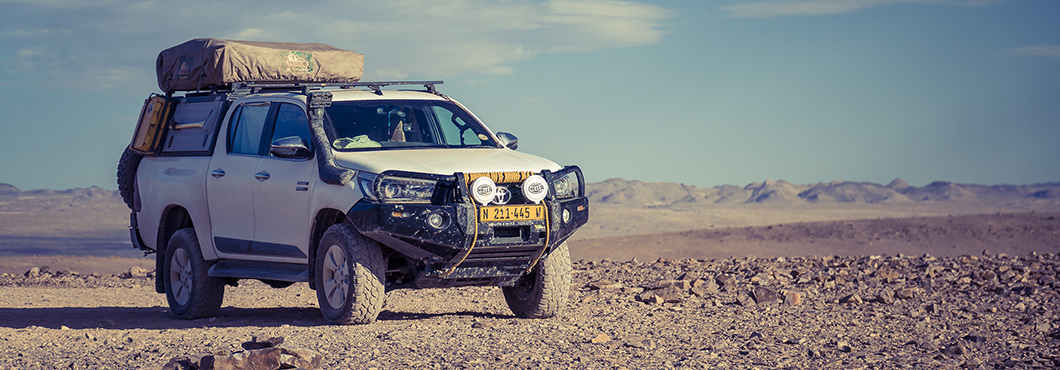
A Car Just For "Showing Off"?
When we arrived at the company - a few kilometers away from the airport and also from Windhoek, we found a small area with approx. 15 good looking cars and met Kimi and Martin.
With Kimi we did all the payment stuff and Martin gave us a proper introduction into the car.
I was wondering a little bit, when Kimi and/or Martin told us about some things about the car, that
we shouldn't use, so for example the HD lifterjack. Martin told us, that it's a very dangerous thing,
and some people already got heavy injuries, when using it.
Kimi mentioned, that this car was more built up for showing off, so she told us, that we shouldn't use the yellow rope on the front bumper, as it is just too weak to pull something out of the mud or whatever.
Dangerous "Gas Bottle Fillup"
I asked her about the gas bottles (also in an email before) and if they have been filled up.
The car has been offered with gas bottles, so at least two of them should be at the car, but it was only one, even if Kimi wrote before, that the gas bottles will be fully filled up.
But even the one bottle wasn't filled up, so at the end it lasted for 5 days, instead of 14. I asked her, where I can replace the bottle, but she told me, that the gas stations won't replace them, they rather would fill it up.
"Filling up a gas bottle is forbidden in germany for a very good reason"
It's very dangerous, when it gets overfilled. Overfilling happened one time to us. When I wanted to get my camera out of the boot, I already heavily smelled the propan/butan, which filled up all the boot.
When the pressure is too high, because of the overfilling, the valve/gauge cannot keep the pressure anymore and lets the gas out until a proper pressure is reached.
Usually the gas bottle is mounted on the outside of the car, but Kimi told me, that the valve always gets dirty because of the dust and then it won't work properly anymore. So people may think, the bottle is defect, but it's just what she said. So we decided to put the bottle in the back of the car.
We really don't wanna think about an outside mounted gas bottle which lets out the gas, when a smoking pedestrian is passing the car. Gladly I didn't smoke, when I was getting my camera out of the back.
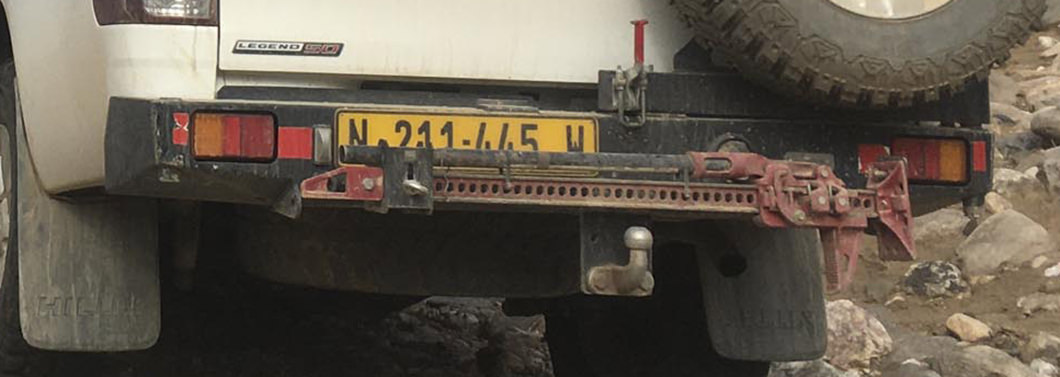
Heavily used tyres and too low pressure
I was wondering, when I then watched the tyres (incl. 2 spare tyres). 3 of them have been heavily used already and one of them got two 2cm long cracks at the sidewall.
They obviously didn't see it and changed it to a "new" tyre after our demand, which ment to be new as one of the guys told us. It actually wasn't, but this later on 😉
I asked the guys about the pressure for gravel, sand and tar and they recommended 180 kpa (1.8 bar) on the front and back for gravel and 200kpa (2 bar) for both on tar.
That made me think, because the car already was heavily loaded and I thought, how sandy all those gravel roads must be, when they just put 1.8 bar on the M/T tyres.
Even without all our belongings the tyres already looked pretty flat and I asked twice, but they said the same and recommended me to always follow the sticker on the car (which tells the same values).
The treads of all tyres (except the "new" one) were pretty much down, one tyre was so heavily cracked, that I already knew, for what purpose it has been used: for heavily sliding above the gravel just for the sake of having some fun.
It was the first time in our 15 years of traveling and rental car experience, that we got so much used tyres, but I initialy thought, they would might have a reason for it, so I just accepted.
A big downside (which one needs to know) is, that the car had 17 inch tyres and those ones are very, very, very rare in Namibia, so we had to drive 640 KM for just one 17 inch tyre. 16 inch are very common though.
They furthermore recommended me to don't drive above 80 km/h because of those "bad" streets and I accepted too. Later on, I knew the real reason for it.
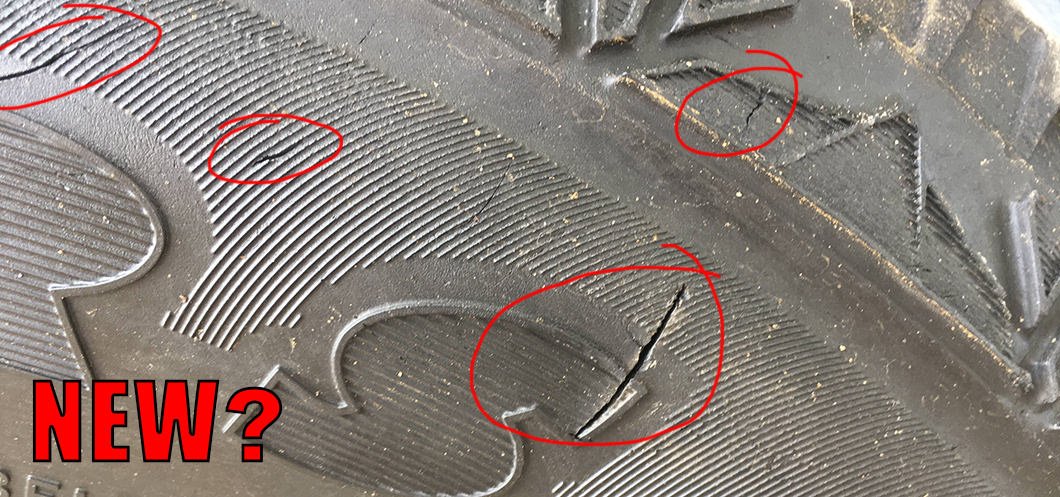
Broken tent zippers, broken spare tyre holder and leaking canopy
The Tentco roof top tent was also heavily used, so it had worn out fittings, broken fabrics and so on, but I didn't pay that much attention, as I cannot expect to get a brand new tent, so what?
But when we used it the first time, we examined, that the zipper of the moskito-net was so worn out, that it took ages to close the zipper... what a 35-day-pain-in-the-ass.
The ladder of the tent had 3 parts and it was so much work to pull it out, that we just took of the last part as it wasn't really needed and made the most work.
Anything else on the car was as expected, the Hilux itself had just 17004 KM on the needle, so pretty much new and good looking (apart from some minor scratches)
The front and back were equipped with heavy duty bumpers from Gobi, much too exaggerated for this kind of environment, but hey... they looked so good 😉
We loved the Engel fridge and my initial doubts about its power consumption turned out totally baseless.
Our food and drinks always had a temperature of about 4°C-1°C, so very cold. The 2nd battery didn't suffer from its power consumption, which was great because we had lots of electronical equipment with us, which needed power too.
When we arrived at our first camp at Gobabis, we saw, that the weldings of the Gobi HD spare tyre holder were already broken, as well as the stopper, so we made some pictures.
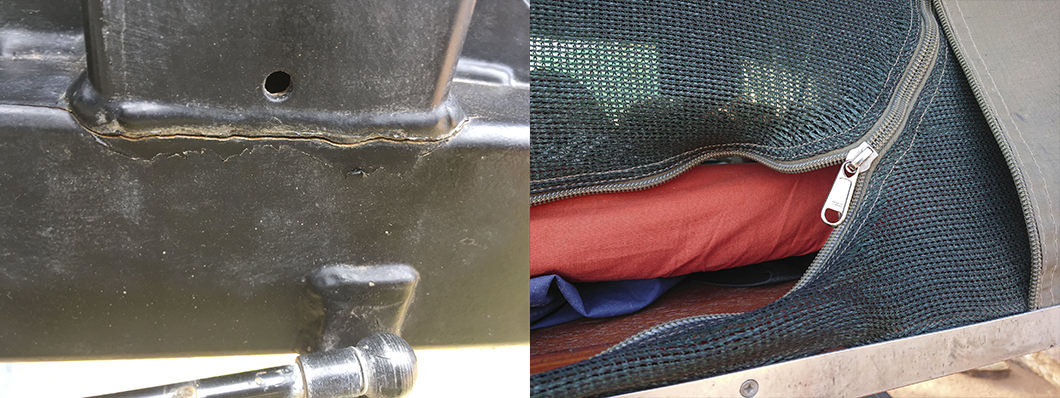
No copy of the completion certificate for us?
When we got into Botswana it heavily rained and then we examined that the aluminium hardtop wasn't really water proofed. Lots of water came into both sides of the back of the car, due to the broken sealing. I already told Martin, when we picked up the car.
Tools, kitchenary and cutlery worked good so far, except for the ceramic kessle and the iron cast pan. It wasn't possible, to take it without a big towel, after heating it up, so Fenny often burned herself, apart from the fact, that the pan weighted 1.6 KG.
So this stuff has been pretty much old schooled, much too heavy in weight and much too heavy to clean.
While checking the car with Martin, he filled out kind of protocoll, where he marked scratches and damaged things on a blueprint, but we weren't supposed to get a copy of it (what?)
So, after signing I made a photograph of it and our journey should begin.
What we observed very early was, that the USB, 220V Plug and cigarette plug was ONLY working, when the car was started and I don't mean, that the ignition would have solved the problem. The cars engine must be running.
So imagine, that you only could charge your phone by letting the engine roar.
I didn't understand this philosophy, as the car has been equipped with a 2nd battery, but glad me, I took my inverter, a 100W solar panel and a few powerbanks with me.
Two Tyre Blow-Ups And One Puncture
After driving 1500 KM in Botswana, moderate temperatures and heavy rain here and there, everything worked fine... until we reached the Etosha Nationalpark.
We drove ca. 30 KM into the Etosha, the temps reached 41°C and our speed was 40 km/h. Suddenly a waterhole appeared where we needed to drive through (no way around). After passing the waterhole, one tyre literally exploded and got a hole of the size of a fist.
Holy Sh*t, what the hack was that?
Fortunately we've got spare tyres, so I changed the broken tyre, but we were always thinking, why that happened? I thought it might have been the temperature differences between the outside temps and the water temps, but after driving hundreds of thousands of kilometers on every single type of road, we never ever had a tyre blow up.
After 400KM driving through the Etosha, we left the park at the Galton Gate, which is at the west end of the park, when we've got a broken tyre again.
This time it might have been one of those millions of thorns from the bushes, which are all around.
I fixed it with a tyre repair kit, which we've got from Safari Car Rental.
At the Etosh Roadside Camp the manager offered me, to buy a new tyre in Kamanjab, a small village 70 KM away from the camp.
The tyre has cost us N$ 2750, which is 165€ (pretty cheap for Europe, but anyways a lot of money).
After leaving the camp we wanted to drive to the skeleton coast... again on a gravel road.
The sign said, we were allowed to drive 120km/h there, so we drove at r.a. 90-110 km/h. Suddenly the 2nd tyre blew up. I changed it again, but now we've got only one spare tyre left.
I was thinking about the reason and took a closer look to the tyres and what I saw, blew up my mind: "M+S" tyres? In Namibia? That must have been a joke, or?
I called Vincent from Safari Car Rental.
"Stupid, unexperienced and unskilled drivers own fault"
When I spoke to Vincent, he mentioned, that I was driving against their regulation, which was saying, that we should (!) drive at max. 80 km/h on gravel.
So one of the "huge" stones on the road might have damaged our tyre and this is usual, if one drives without needed skills that fast on the "worst roads on the planet."
I instantly had my first argument with him and told him, that their "regulations" are just a recommendation or an advice, but if the law says, that I'm allowed to drive 120km/h, I could do so.
I also told him, that I'm a well experienced driver and that I know, what I'm doing.
Furthermore I asked him, why they're using M+S tyres in an environment like this and that they're not in any way appropriate for such tours in such a country. They should better be used in Romania at winter time.
He was asking me, if I wanna say, that he uses the wrong tyres and I just answered: "YES, you definitely do...!
At the end I asked him, where to go for getting a new tyre and he sent us back to Outjo, a small town 320 KM into the opposite direction, so a detour for us of about 640 KM (for just spare tyres).
He told us, that there's the "Weimans Garage" and that he would call those guys and send a new tyre to them. The next day at 10 am it should be available.
On our way to Outjo, we stopped at Palmwag, a very tiny village with a lodge and a tyre service.
We asked the guys there for a new tyre and they said, that 17inch tyres are not common and that they do not have one to sell.
I furthermore asked him to take the damaged tyre of the spare wheel and to take the spare tyre under the car and swap it with the tyre, I already fixed with the set.
He did so and after checking the pressure of the spare tyre, he said, that even the spare tyre has got a puncture and is just flattened.
What?... my never used spare tyres is already flattened?
In the meanwhile, Sonja examined the blown up tyre and saw, that even this so called "brand new" tyre has got a puncture already and was fixed with a patch from the inside.
Allright: at the end it's like this, that this car was equipped with M+S (sort of winter tyre), we've got an already repaired tyre on the front left and a flattened tyre as a spare under the car. WOW!
I asked the guy, why the tyres have gotten a blow up and he mentioned, that the pressure seems to be way too low and that he would increase it up to 2-2.5 bar.
I denied, though, because of SCR regulation.
Broken hose clips, lost gasoline and again: the pressure question
Swallowed all that, we drove further - with a 2 times repaired spare tyre and a fixed tyre on one of the axles - to a farm, 100 km away from Outjo.
Just to mention it before: the tank-needle was still at max.
As the car got a 2nd gasoline tank where the 2nd tank will empty at first without changing the needle of the main tank, we knew, that we still had a full main tank.
In the morning we headed further to Outjo and I was wondering, why the tank needle moved so fast to the middle, but thought it might be some measuring problem.
We stopped at a Total gas station to fill up the gas and the service guy suddenly called me:
"Look at this, there's gasoline coming out of the car"
At the end, the hose clip of the connection hose between main and 2nd tank got loose.
He and another guy needed 45 min to fix 3 hose clips (which weren't fixed, btw).
So on this 100KM way on tar road, we almost lost half of the gasoline of the main tank.
We drove further to Weimans Garage (kind of tuning garage for expedition cars), where a so called "Parking Boy" was standing and told me, that Weimans had closed for today. I said, that we've got an appointment and knocked at the door.
Jery from Weimans Garage opened the door and when I asked him about the tyre, he answered, that they are closed, can't do anything and that nobody called them. They neither got a new tyre.
I called Vincent from SCR again and asked him to speak to Jery.
After that Jery told me, that I had to pick up the tyres (more than one?) from NamPost and then I should drive to a company called "Highway Service". We should speak to a guy called Jan, as Vincent would have called him already.
I even asked Jery about the tyre-pressures and he mentioned nearly the same as the guy from the lodge, where we were before. 2 bars on the front and 2.2 up to 2.8 on the back (depends on the load) for gravel... and even higher on tar.
OK, that confirmed my initial doubts at Safari Car Rental.
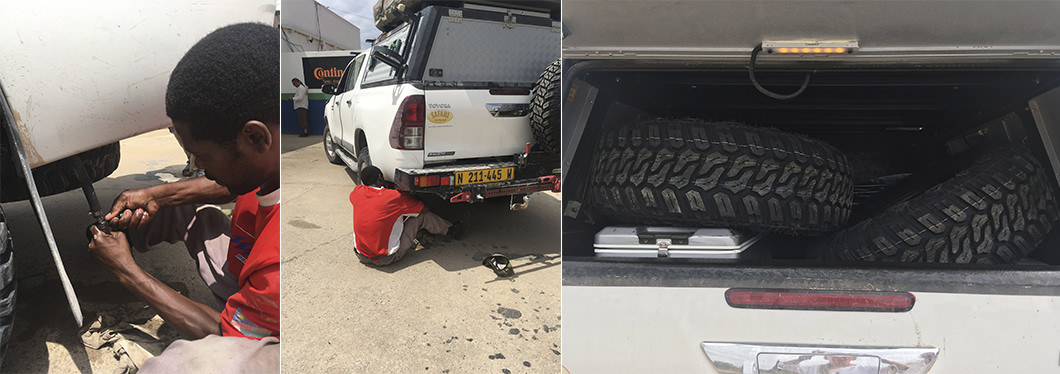
So we drove to Nampost, picked up the tyres (from which I ordered just one, instead of two).
I called Vincent again, just for asking what to do with the second tyre, as I don't wanna pay 3 tyres now. He mentioned, that I should leave the 2nd tyre at the "Highway Service", they already know.
OK, off to the next company.
I went into the office and asked for Jan.
He said, he doesn't know anything about a tyre swap, nor he wanted to get a new tyre, as they usually are using different brands.
So I called Vincent again: "OK, now it's getting seriously silly, what's going on"?
"Durcheinander" he said in a broken german.
I asked him to speak with Jan, who later on wanted to sign for the 2nd tyre, as they were supposed to sent it back to whatever person or service.
I futhermore asked for checking the gasoline-hose again and again 2 guys needed 50 mins to finally fix it, coz gas still ran out.
After all these hassles we picked up our way again and drove for the rest of this 8000 KM journey without any problems, but with a higher pressure and an adapted speed, dependent on outside temperatures and road constitution.
So, what's the conclusion on this?
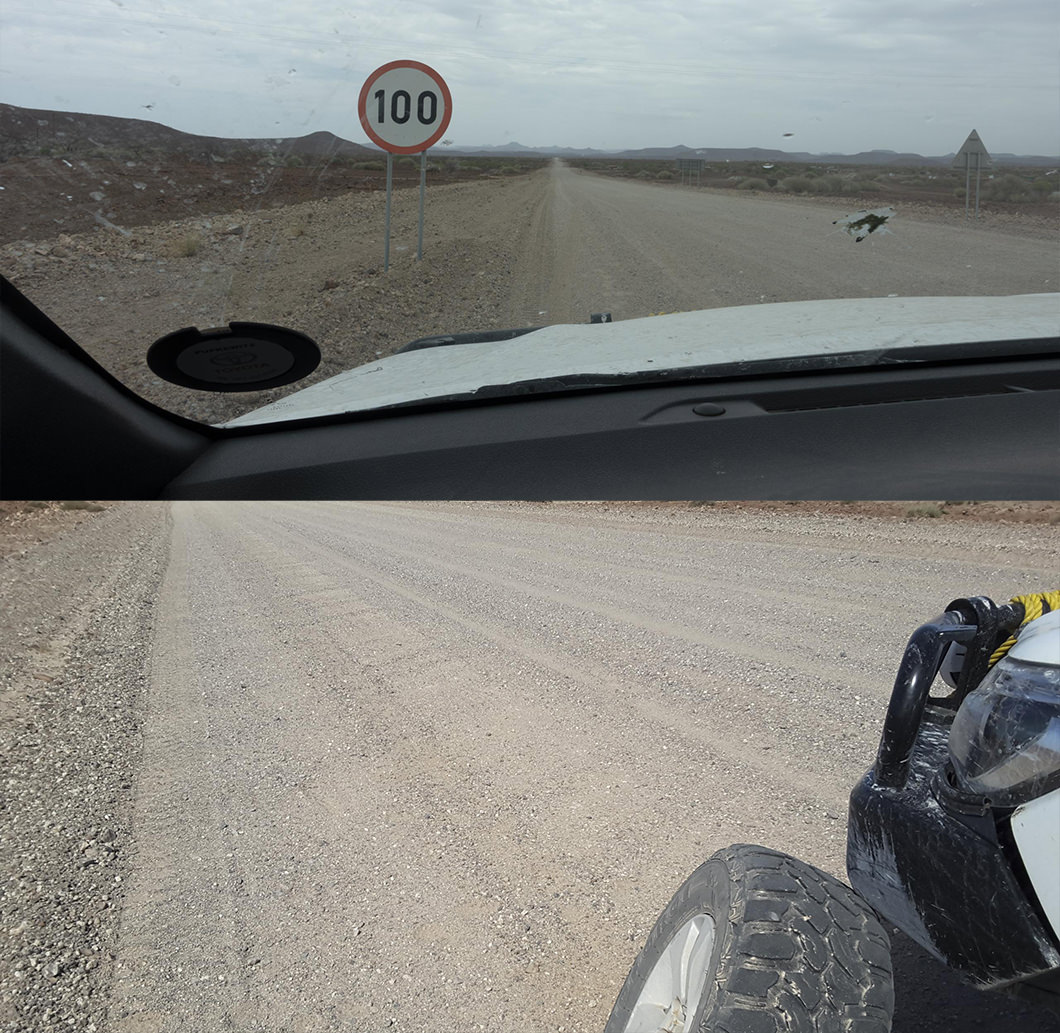
Safari Car Rental asks you to drive at max. 80 km/h on gravel roads, because it happens "all the time", that drivers are sliding the car and getting into an accident.
They're using cheap and weak M+S tyres, which mostly are 100% running out of their specs, in an environment of 40°C, at much too low pressures and for that much too much load.
They try to make you believe, you're just too unskilled for that bad Namibian roads.
We did some research and the truth is the other way around:
First of all: Namibian gravel roads are mostly much, much better, than the gravel roads in the Western Alps, Argentina, Chile, Montenegro and Morocco for example (we drove all of them).
I called Namibian gravel roads "beds of roses" and Fenny always said: "As long, as my boobs are not acing - like in Argentina - these roads are just fine".
On all our tours (350.000 KM, since 15 years now) we never had a blown up tyre, even with 110 km/h on heavily corrugated roads like the ones in Argentina, which are by far much worse then the roads in Namibia.
So, when there's a sign with 100/120 km/h in Namibia, you can do so... NO special skills needed! You just need the right tyre!
Our research brought out the following:
. Bridgestone recommends to DO NOT drive M+S / Winter tyres outside of winter surroundings.
. The Namibian AVIS Rental Guide recommends: On an 4x4 Double Cab, the standard pressure shall be 2,6bar (Front and Back)
. The "Namibian National Road Safety Council" brought out a paper, where it also says, why M+S/Winter tyres definitely shouldn't be used on Namibian roads and even
. Harold Pupkewitz from Pupkewitz Cars (the car dealer, where OUR rental car came from initially!)
mentioned the same in several interviews inside the paper above.
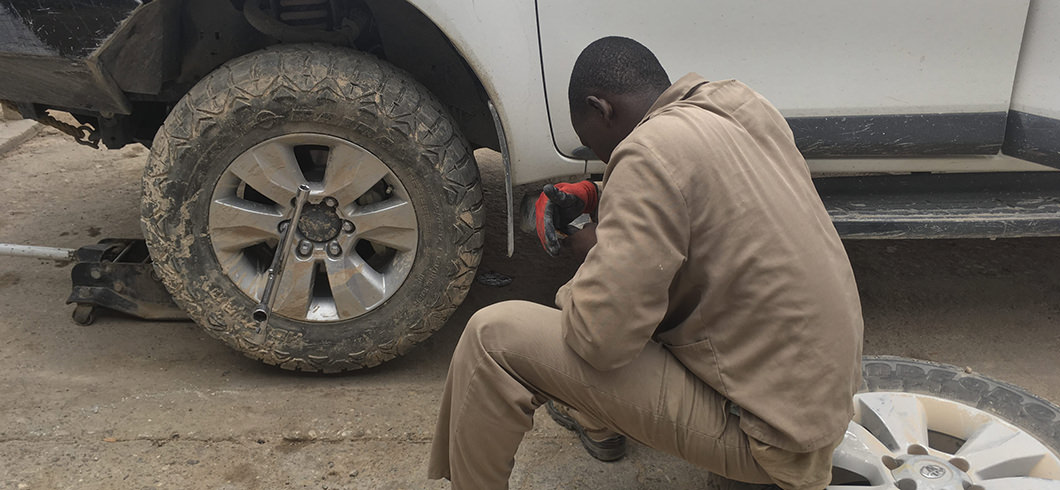
Our personal conclusion:
These cheap China-tyres (Catchfors/Windforce/Lanvigator) are just weak (I'd say: no matter which environment!).
The sidewall is something around 3-4mm thin, whereas a proper tyre sidewall is way thicker (Cooper STT i.e.)
The M+S tyre can't stand the low pressure at very high outside temperatures (avg. 35°C) and the "heavy weight" of the vehicle at a speed of 90km/h and more.
I made several temperature tests. With the given setup (by SCR), the tyre got so unbelievable hot, that it was impossible to touch it.
If I lowered the speed, it got better, but when we increased the pressure from 1.8 to 2bar (front) and 2.2bar (back), the tyre has been easily touchable, even at 40°C and 110km/h on gravel.
So what does it say about Safari Car Rental?
They buy very cheap tyres and at the end will be putting the costs onto their customers.
Keep in mind: you have to pay for the used profile!
The customer has to pay the damaged tyres, except when he pays for an additional and expensive insurance and even then only ONE tyre will be paid by SCR.
We met many people from different car rental companies in Namibia and some of them even had 5(!) blown up tyres as well as dozens of punctures. It's a well known fact, that in Namibia second-hand tyres, as well as winter tyres will be used. (see paper above)
SCR gives you the impression, you're an unskilled driver, what on the other hand implies, that every single Namibian isn't able to handle these roads. Why? Because we never ever did see so many tyre-repair shops in another country.
I would say, you'll be able to find one every 50 KM... even in the deepest bush.
And with their silly joke-signs about blown up and flattened tyres in their office, they make it even worse and in the beginning I really believed that - sorry - bullshit.
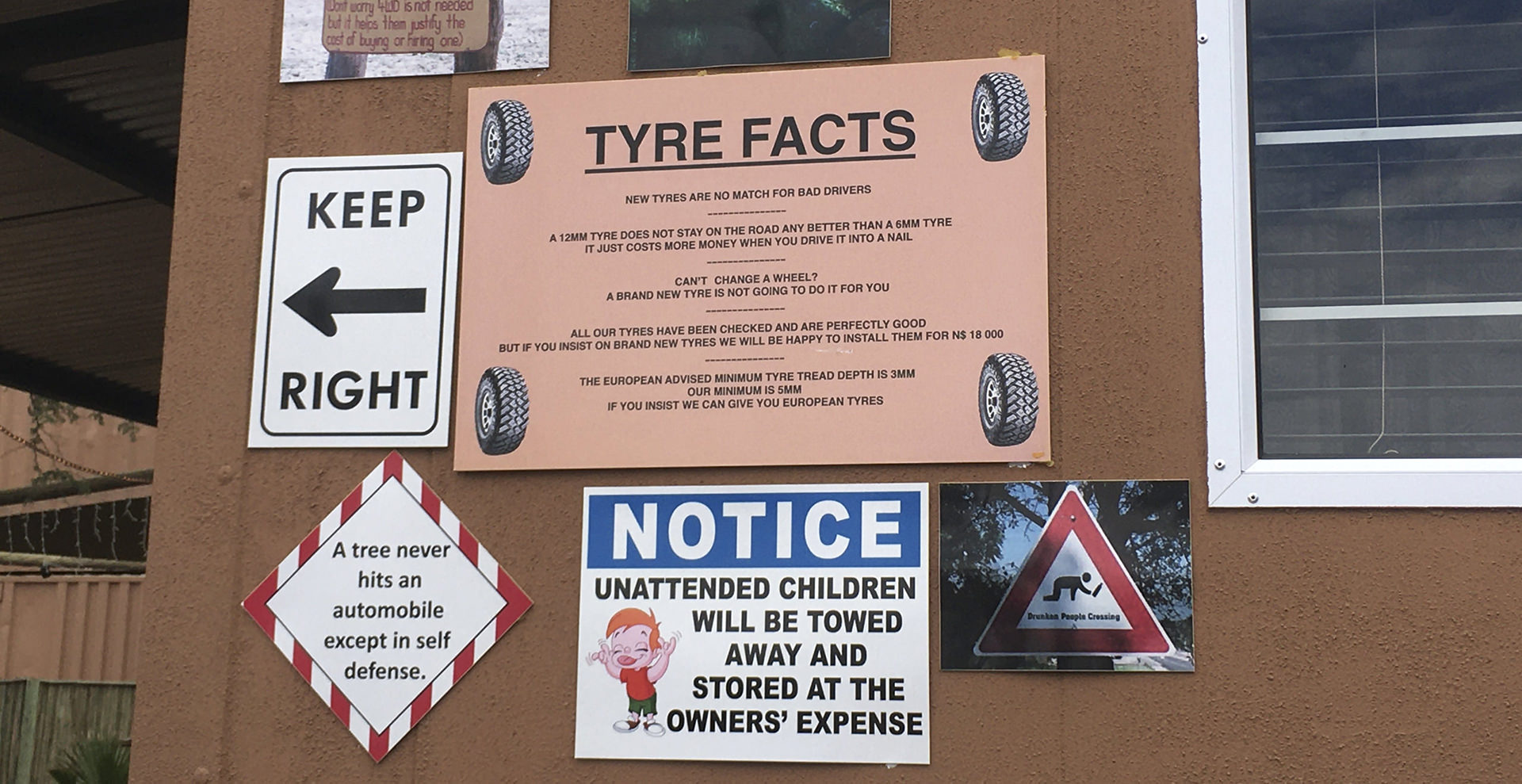
It's not the "Stone, that runs after your car"
to damage it", nor it's the "tree, that's following you, to give you a puncture"
It's also not your drivers missing skill, that damages these "millions" of tyres (you'll see 1000s along all these roads). It's just this super bad, cheap and unreliable China-Crap, as well as technical nonsense which they tell you, which brings all you guys in trouble.
Here Are Our Tipps:
. Watch the tyres profile.
If it's a bit more down than usual, but looks good-> do not care so much.
If it's cracked, with broken out pieces-> it's heavily used for fun-sliding on purpose.
. Check all spare-tyres and let you show the pressures.
. Check the pressure and touch the tyres.
If they're getting really hot: increase the pressure a bit (or drive slower, depending on outside temp).
. If you strictly wanna follow their regulations:
DO NOT drive above 80-90, no matter how far your ride will be and how long your ride gonna take.
. If the car is equipped with "Lanvigator, Windforce or Catchfors"-> think about it, it's up to you 😉
. If the tyre is a M+S tyre: Well... what to suggest?-> decide yourself 😉
All in all, we do not want to recommend Safari Car Rental, as their 24h service wasn't as expected.
It costed us time, nerves, kilometers, lots of gasoline and money. The rental car was more made for show off, heavily used and bad tyres were equipped as well as they (indirectly) call their customers kinda "stupid" or at least unskilled.
If nothing would have happened, maybe everything would have turned out fine, but as we say: "The devil is in the details". And these speak for themselves.
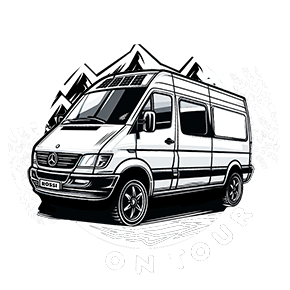
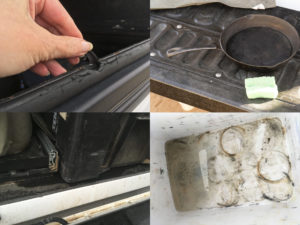
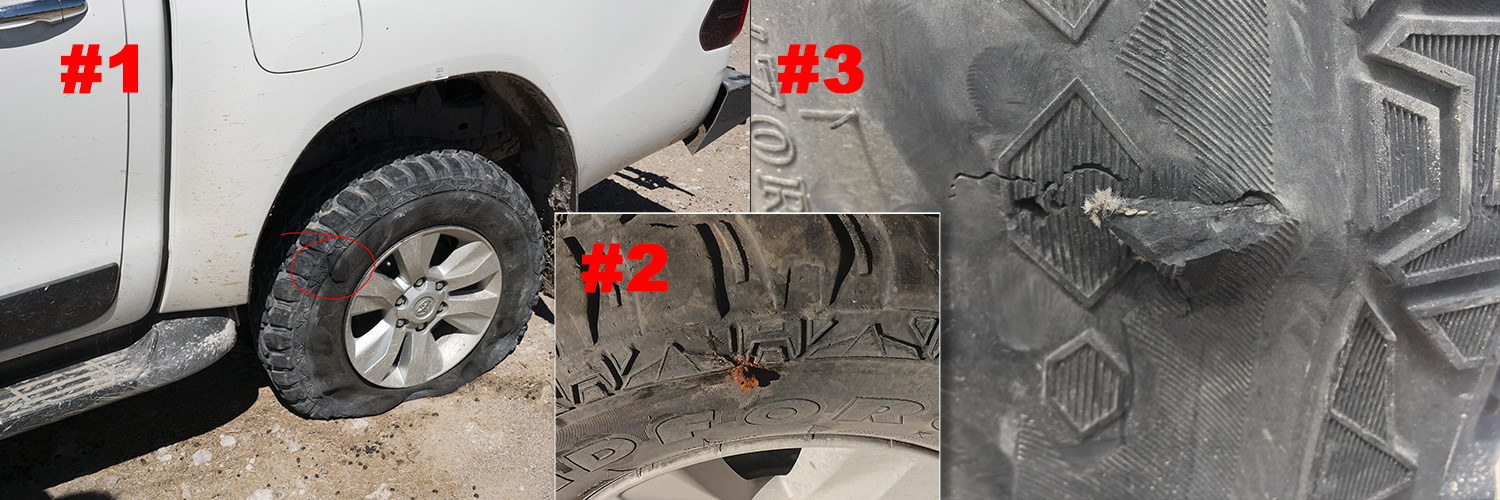
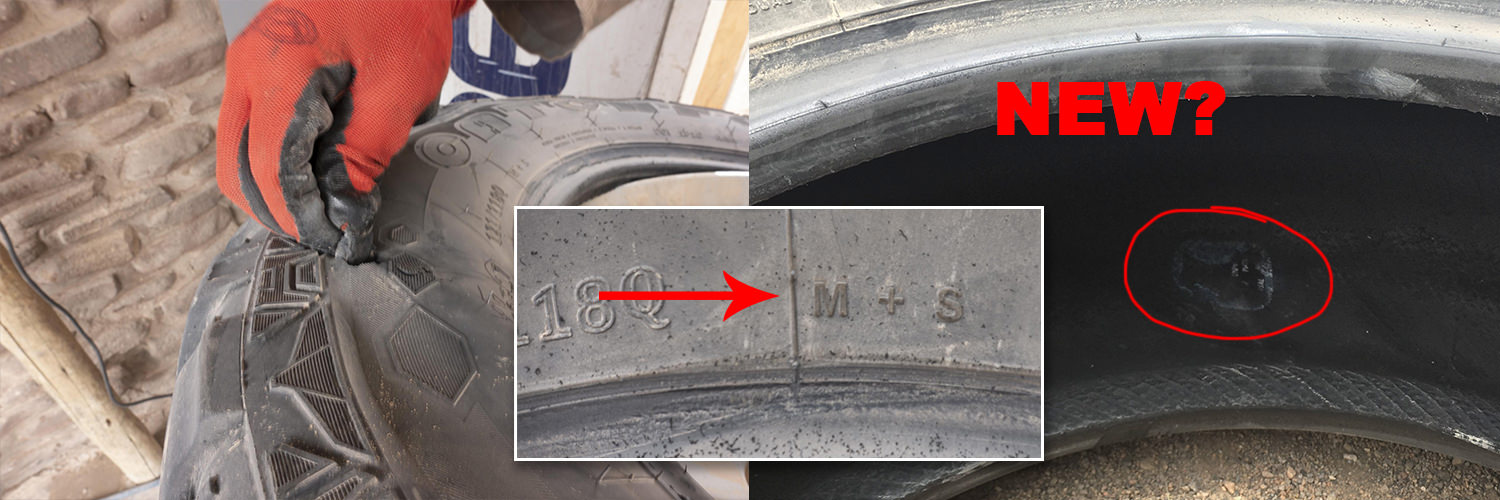

Hi, really bad to hear your ammount of problems you had with this rental car company… I am a bit suprised, because i know people who recommend it a lot, and return renting vehicels from them…
Certain things sound really gnarly and are not to believe (M+S-Tires, used vs. new), but in other things you seem to add a lot of “temperature” of your tires-problems: p.e. the steel pots are standard and can be put direct into a fire – if you use iron cast post at home you’ll burn your fingers to.
Certain things do wear out, so its difficult to say, if your loose gas hose appeared new because of the corrugation, or it was because of lacking maintence…
I had problems too adjust about the reccomendation off max. 80km/h, but this is a common sense in all rental companies throughout Namibia. There are even companies who monitor your speed online! The main reason for this is, that road conditions can vary within meters and you end in deep sand suddenly, and because of the high weight in these vehicules its easy to have dangerous rollovers! If you reduce your speed, the probability reduces a lot.
But in the end there def. were a lot of “no-gos” in your rental, and i will keep your comments in mind with our next rental (check tire pressure at the begin and check tyre typ).
Hopefully your next experience will be better! Best regards, Michael
Hi Michael. That was the reason for us, going with them as well. As long as nothing happens, they might be fine, but once you’ve got problems, YOU are the stupid and unskilled drivers, even though we’re overlanding since 2005 and did hundreds of thousands of kilometers, like in Chile, Argentina and lots of other countries, with even worse roads.
Anyways: all the best for your travels… always have a safe journey and lots of fun 🙂